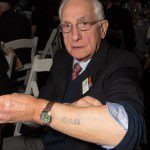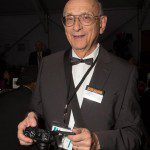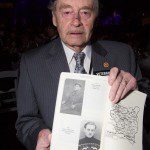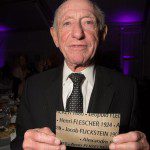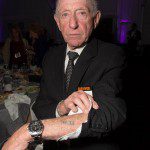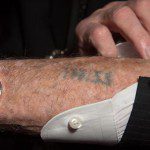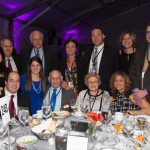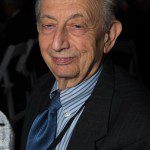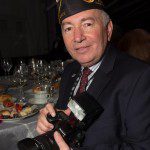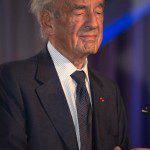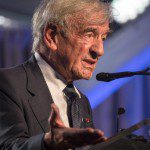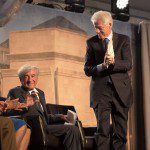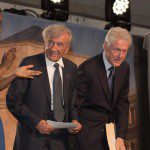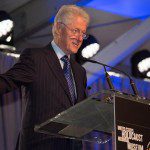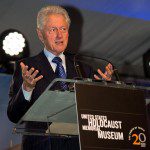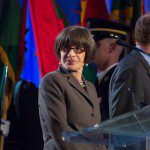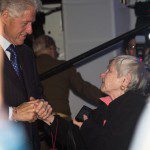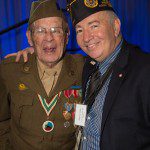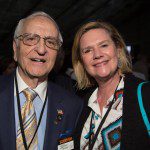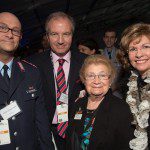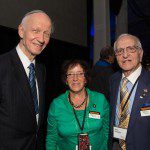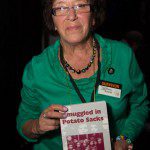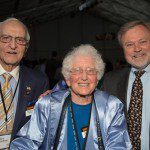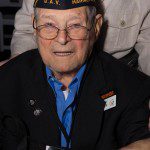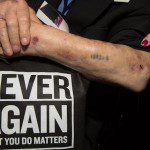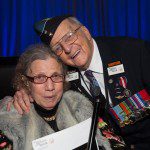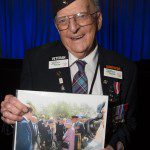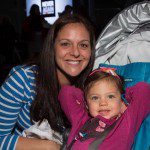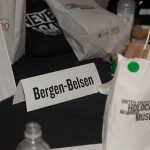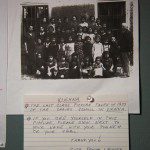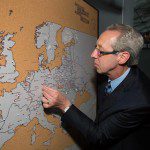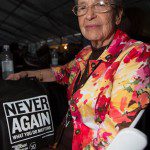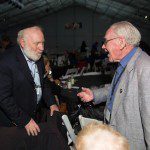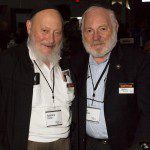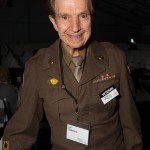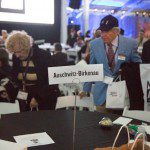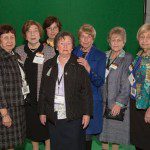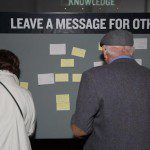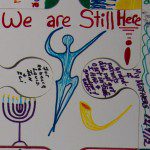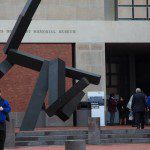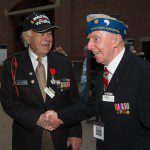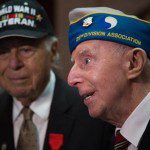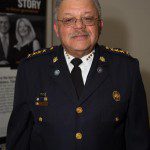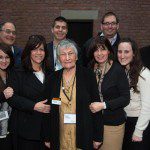‘Never Again’: Holocaust Museum’s 20th Anniversary Tribute to Survivors, Veterans
By • July 11, 2013 0 6026
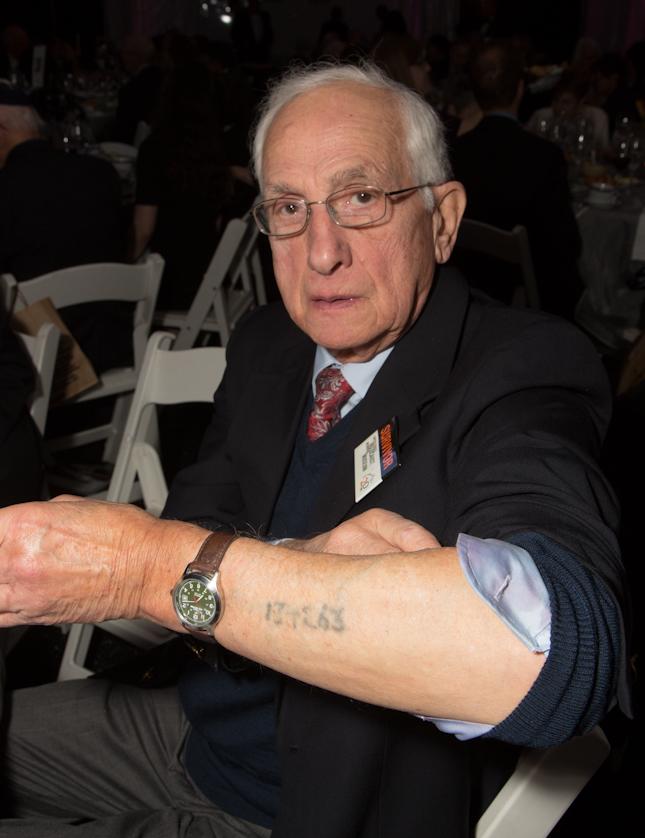
The philosopher George Santayana penned the now famous words: “Those who cannot remember the past are condemned to repeat it.”
Heeding that warning, nearly 1,000 survivors of the Nazi Holocaust as well as veterans of World War II joined former President Bill Clinton and Nobel Peace laureate Elie Wiesel on April 29 to mark the 20th anniversary of the opening of the U.S. Holocaust Memorial Museum. The museum’s paramount mission is to preserve the memory of the millions who perished at the hands of Nazi Germany and Adolf Hitler — and by doing so helping assure that it will never happen again. This month marks the 68th anniversary of Hitler’s death and the unconditional surrender of Nazi Germany, thus ending World War II in Europe. Organizers of the event decided not to wait for a 25th commemoration of the museum’s debut — simply because many of those that experienced the war firsthand may not be alive in 5 or 10 years.
Wiesel told the assembled audience of survivors and supporters that the museum’s purpose is as much to serve future generations as it is for those who lived through the Holocaust. “I say to young people, you are our hope,” he said. “Whatever we do now is not only for the sake of the past but surely also for the sake of the future, and you are our future.” Since opening in 1993 at Wiesel‘s suggestion, the museum has been one of Washington’s most visited sites. More than a third of its 35 million visitors have been schoolchildren.
On the evening before the anniversary ceremony at a dinner, Susan Eisenhower, granddaughter of General Dwight D. Eisenhower, received the museum’s highest honor, the Elie Wiesel Award, on behalf of all World War II veterans. More than 100 of those veterans were in attendance. Many had been soldiers in units that liberated concentration camps.
Bill Clinton warned that the roots of the Holocaust are “alive and well” today.
“I ask you to think about how the historic suffering and slaughter of the Holocaust reflects a human disease that takes different forms — the idea that our differences are more important than our common humanity . . . ,” Clinton said. “Most of us spend 99-and-a-half percent of our time thinking about the half-a-percent of us that is different from everybody else, and that makes us vulnerable to the fever and the sickness that the Nazis gave to the Germans. . . . You know the truth. You have enshrined it here. You must continue to work to give it to all.”
Attendees at the event each received a black carry bag with the words, “Never Again,” emblazoned on the front in large letters. Underneath in smaller letters were the words, “What you do matters.”
You can view several of my photographs from the event by clicking on the photo icons below. These are some of the people you will see.
Survivor Samuel Rosen, age 91, now living in Scranton, Penn., pulled me over to his table to take his photo surrounded by members of what he calls his “new family,” his two sons and their children. Rosen was able to sneak out of Czechoslovakia and across the border into Hungary where he obtained false identification papers that let him pass as a Catholic Polish immigrant. When he returned to his home town after the war, he found it nearly deserted as most of the Jewish population had been wiped out. Rosen lost his entire immediate family — mother, father, six brothers and five sisters.
“I have a story to tell,” said Leo Zisman. Attendees were encouraged to share lunch at designated tables where they might share memories with fellow survivors. I met up with two brothers Leo, age 81, and Berel Zisman, age 83, at a table marked for “Kovno.” The brothers survived in Kovno Ghetto in Lithuania, the Warsaw Ghetto, Dachau, Mauthausen and Auschwitz Birkenau. (where Leo spent his bar mitzvah.) and finally a death march. Of the 141 children who went with them to Auscwhitz, only six survived. Twice, Leo had a gun pointed at his head, he said. After the war in 1946, Leo came to the U.S. as a 15 year old with only $5 in his pocket. He went to college and then prospered as a builder and developer in New York City. Berel is a rabbi. Leo is the title character of an award-winning documentary, “The Lion of Judah,” based on his trip back to Poland leading a group of young adults. “There is nobody here,” lamented brother Berel, noting how few others there were at the table. By his own account, many native Lithuanians were complicit in rounding up members of his family and others.
Samuel Bradin, age 83, showed me his tattoo. During the Holocaust, concentration camp prisoners received tattoos only at one location, the Auschwitz concentration camp complex. Bradin now lives in Rockland County, N.Y., a survivor of Aushwitz where he was as a 13 year old, the only member of his immediate family to survive the camp. He was liberated from Bergen Belsen on Jan 17, 1945, and came to the US in 1949. He wrote “God Bless America” on my note pad.
Survivor Henry Flescher, age 89, was born in Vienna, Austria, and initially escaped to France where he was eventually interred in Drancy deportation camp, a place where Jews, Gypsies and others were held before being shipped to the German concentration camps. On the matter of the Vichy French, Flescher simply says, “Petain gave me to Eichmann.” (Phillipe Petain was the head of Vichy France from 1941 and 1944 and convicted of collaboration with the Germans after the war.)
There were the 10 women from Club Nissim of the Boro Park YWHA in Brooklyn, N.Y. This day program for Holocaust survivors was named by its members in recognition of their miraculous survival (Nissim is the Hebrew word for “miracles”). Many were children when rescued from Nazi-occupied Hungary by the courageous actions of Raoul Wallenberg, a Swedish diplomat credited with saving tens of thousands by providing them with protective passports and sheltering them in buildings designated as Swedish territory. (The street outside the event in Washington, D.C., is named for Wallenberg.)
Proudly wearing his veterans cap, Holocaust survivor Paul Argiewicz from Salem Wisconsin displayed his concentration camp number tattooed on his forearm. He was only 11 when the Germans invaded Poland and he was taken to a concentration camp. He was able to convince soldiers he was 18 and could work in a quarry and later as an electrician.
During the war, Argiewicz estimated he was taken to seven different concentration camps, including Buchenwald and Auschwitz. Only he and his sister Lucy survived. His mother, father and another sister died at Auschwitz. His life is also the subject of a book, “Number 176520, the Story of Paul Argiewicz, a Teenage Holocaust Survivor,” by Deanne Joseph Ebner. After surviving against incredible odds, Paul Argiewicz immigrated to the U.S. and served in the military during the Korea War.
Survivor Gigi McKendric, an accomplished artist in metals, plaster, mechanized motion of sculptures and lights, said that the consistent theme that informs her body of work is the belief that no matter how terrible the challenge – the spirit survives.
George Oscar Lee, age 88, opened his book and showed me pictures of himself from his days in the Polish Army and in a displaced persons camp in Bavaria in 1945. He was born, a Jew, in Drohobycz (then Poland) on September 1, 1924. War broke out on his 15th birthday. Believing that the Germans were going to conscript men for labor camps, he and his father ran east, into Russia, where they survived for some time living in the Ural Mountains. Lee then enlisted in the Polish military attached to the Soviet forces and helped liberate Warsaw. At war’s end, he had made it to Berlin. He had no home to return to and came to the U.S. through DP Camp Foehrenwald, where he met his wife and mother of his children.
‘Rona Zinger held a copy of her book with her story, “Smuggled in Potato Sacks.” Zinger was born in the Kovno Ghetto, when such births were “verboten,” according to a German order of July 24, 1942. Rona’s mother was Ronia Rosenthal, the baby rescue activist, who found willing foster parents outside the ghetto for an unknown number of babies within the ghetto. Her father was Shmuel Rosenthal, a teacher in the ghetto, who taught in the Underground School of the Ghetto. In November 1943, the 10-month-old Zinger was drugged so that she would not cry or scream and was carried out by her foster father when he joined Jews going to work. She survived with the help of a foster mother and was re-united with her father in 1949. Her mother had perished.
Henry Greenbaum, age 85, of Bethesda, Md., spent his years 12 through 17 in one camp or another. He was born Chuna Grynbaum in Starachowice, Poland, on April 1, 1928. In 1944, Greenbaum was deported to Auschwitz and incarcerated in the Buna-Monowitz subcamp, where the I.G. Farben Company owned a factory established for the purpose of producing synthetic rubber and fuel. As the Soviet army approached, Greenbaum was evacuated to Flossenbürg, a concentration camp near the Czechoslovakian border. When American forces neared Flossenbürg a few months later, the prisoners were sent toward Dachau on a death march. Greenbaum was liberated at Neunburg vorm Wald on April 25, 1945, by American soldiers from the 11th Armored Division. When liberated, Greenbaum weighed only 75 pounds on a diet of leaves.
Today, Greenbaum serves as a volunteer at the U.S. Holocaust Museum, sharing his story with visitors.
Ludwik Szymanski, M.D., who was hidden as a child in Warsaw, is now director emeritus of psychiatry at the Institute for Community Inclusion. He was awarded the Lifetime Achievement Award at the Children’s Hospital Boston Division of Developmental Medicine awards ceremony. He was recognized for his more than five decades of commitment to psychiatry and his deep affection for supporting and improving the lives of people with disabilities.
World War II veteran Herman Zeitchik, age 89, of Silver Spring, Md., proudly wore his French Legion of Honor Medal which he earned by landing at Normandy, helping to liberate Paris and holding back Nazis at the Battle of the Bulge. He also helped to liberate starving prisoners at the Dachau concentration camp.
Friends and survivors, Henry Klapholz, age 80, and Jerry Stein, age 84, sit together at Table 158. Henry Klapholz, from New Rochelle, N.Y., escaped Germany a day before the start of the war as a 5-year-old, first to England and then to the U.S. His friend Jerry Stein of Englewood, N.J., is a survivor of Auschwitz’s I.G. Farben factory slave labor complex near Buna where he spent almost a year as a bricklayer. On Jan. 18, 1945, 16-year-old Stein was taken out of Auschwitz and put on a forced death march to the nearby town of Gleiwitz. There, Stein recalls, he was stuffed into an open-air train car along with thousands of other Jewish prisoners and the train was sent off, as the Nazis hunted for another camp in which to house them. It was a full week before the inmates were unloaded at the Dora camp in Nordhausen, Germany. Then, he was liberated by the Russians. Stein bragged of his three children, 14 grandchildren, and 27 great grandchildren. This expanding family is “not done yet,” declared Stein. “So we beat them”.
Reuven Flaum, age 86, was playing soccer on a Sunday in Soviet-occupied Lithuania when the Germans invaded his town. Rather than return home and certain capture, he escaped to join the Soviet army. In 1943, as a teenager, he fought against the Nazi push toward Moscow on the Eastern Front.
One of the more than 100 veterans to attend was Tech. Sgt. Val Dadamio, even now wearing his old uniform. Dadamio was with the 11th Armored Division that liberated Mauthausen Concentration Camp. The 11th Armored Division was recognized as a liberating unit by the U.S. Army’s Center of Military History and the U.S. Holocaust Memorial Museum in 1985.
Ed Carter-Edwards held a photo of himself being greeted by Queen Elizabeth II. A veteran of World War II, Carter-Edwards was the driving force behind the recent CBC special, “Lucky Ones: Allied Airmen and Buchenwald.” He was one of 168 allied flyers, including Canadians like himself, who were shot down over Nazi-occupied Europe and sent to the brutal Buchenwald death camp for three months instead of a prisoner of war camp. They became members of the KLB (initials for “Konzentrationslager Buchenwald”) Club.
Donald R. Shearer, another member of the KLB Club, was a gunner for the 391st Bomb Group, 573rd Bomb Squadron, and flew 46 missions before being shot down in 1944 during a mission over France. Shearer was interrogated and put in solitary confinement before being loaded in a boxcar with other people and sent to the concentration camp at Buchenwald, near Weimar, Germany. Moments before he and his group were about to be shot, they were miraculously transferred from the concentration camp to a POW camp on orders of Luftwaffe Commander Hermann Goering where they sat out the war.
Veteran Donald McCarthy, age 89, saw some of the heaviest fighting in the war as part of the first assault group on Omaha Beach on D-Day. He began to choke up and said: “By seeing this museum, it brings back the horror of what happened… As kids, we didn’t know why we were fighting ’til we got on the beaches… It is so important to remember what this is all about and why there was a WWII in the first place.”
Please view my photos of these remarkable individuals by clicking on the photo icons below. If you haven’t done so already, come to the Holocaust Museum and take along the young people: “What you do matters.”
- Samuel Bradin, age 83, spent his 13th year at Aushwitz and was the only member of his immediate family to survive the war. He displayed the tattoo he received at the camp. | Jeff Malet
- Survivor Ludwik Szymanski was hidden as a child in Warsaw. Ludwik Szymanski, MD, Director Emeritus in psychiatry at the Institute for Community Inclusion, was awarded the Lifetime Achievement Award at the Children’s Hospital Boston Division of Developmental Medicine awards ceremony. He was recognized for his more than five decades of commitment to psychiatry and his deep affection for supporting and improving the lives of people with disabilities. (photo by Jeff Malet)
- George Oscar Lee (88) shows a pictures of himself from his days in the Polish Army and from his days in a displaced persons camp in Bavaria in 1945. He was born, a Jew, in Drohobycz (then Poland) on September 1, 1924 – war broke out on his 15th birthday. Believing that the Germans were going to conscript men for labor camps, he and his father ran east, into Russia, where they survived for some time living in the Ural Mountains. Lee then enlisted in the Polish military attached to the Soviet forces, and helped liberate Warsaw; at war’s end he had made it to Berlin. He had no home to return to, and came to the US through DP Camp Foehrenwald, where he met his wife and mother of his children. (photo by Jeff Malet)
- Survivor Henry Flescher (89) was born in Vienna Austria and initially escaped to France where he was eventually interred in Drancy deportation camp, a place where Jews, Gypsies, and others were held before being shipped to the German concentration camps. On the matter of the Vichy French, Henry simply says “Petain gave me to Eichmann”. (photo by Jeff Malet)
- Survivor Henry Flescher (89) shows off his tatoo. During the Holocaust, concentration camp prisoners received tatoos only at one location, the Auschwitz concentration camp complex. He was born in Vienna Austria and initially escaped to France where he was eventually interred in Drancy deportation camp, a place where Jews, Gypsies, and others were held before being shipped to the German concentration camps. On the matter of the Vichy French, Henry simply says “Petain gave me to Eichmann”. (photo by Jeff Malet)
- Survivor Henry Flescher (89) shows off his tatoo. During the Holocaust, concentration camp prisoners received tatoos only at one location, the Auschwitz concentration camp complex. (photo by Jeff Malet)
- Survivor Samuel Rosen (age 91) from Scranton PA (seated center) asked to pose with members of what he calls his “new family”, his two sons and their children. Rosen was able to sneak out of Czechoslovakia and across the border into Hungary where he obtained false identification papers that let him pass as a Catholic Polish immigrant. When he returned to his hometown after the war, he found it nearly deserted as most of the Jewish population had been wiped out. Rosen lost his entire immediate family — mother, father, six brothers and five sisters. (photo by Jeff Malet)
- Tom A. Bernstein was appointed chairman of the United States Holocaust Memorial Council by President Obama in September 2010, jere addressing the National Tribute Dinner on April 28. (photo by Jeff Malet)
- Susan Eisenhower, granddaughter of General Dwight D. Eisenhower, speaks after receiving the Museum’s highest honor, the Elie Wiesel Award, on behalf of all World War II veterans (photo by Jeff Malet)
- Susan Eisenhower, granddaughter of General Dwight D. Eisenhower, speaks after receiving the Museum’s highest honor, the Elie Wiesel Award, on behalf of all World War II veterans (photo by Jeff Malet)
- Survivor George T. Hahn (age 82) was a seven year old in Vienna Austria in 1938 when he was able to escape to New York City. (photo by Jeff Malet)
- Friends and survivors, Henry Klapholz (80) (left) and Jerry Stein (84). Henry Klapholz, from New Rochelle NY escaped German a day before the start of the war as a 5 year old, first to England and then to the U.S. Jerry Stein of Englewood NJ is a survivor Auschwitz’s I.G. Farben factory slave labor complex near Buna where he spent almost a year as a bricklayer. On Jan. 18, 1945, 16-year-old Jerry Stein was taken out of Auschwitz and put on a forced death march to the nearby town of Gleiwitz. There, Stein recalls, he was stuffed into an open-air train car along with thousands of other Jewish prisoners and the train was sent off, as the Nazis hunted for another camp in which to house them. It was a full week before the inmates were unloaded at the Dora camp in Nordhausen, Germany. Then he was liberated by the Russians. Stein brags of his 3 children, 14 grandchildren, and 27 great grandchildren and “not done yet”. “So we beat them” (photo by Jeff Malet)
- Manny Vidor is the son of survivor Esther Vider and Sal Vider of Dixhills, NY. He works as a photojournalist for the Armed Forces. (photo by Jeff Malet)
- Elie Wiesel addresses the National Tribute Dinner (photo by Jeff Malet)
- Bill Clinton listens to Elie Wiese on Monday April 25 (photo by Jeff Malet)
- Elie Wiesel addresses the National Tribute Dinner (photo by Jeff Malet)
- Elie Wiesel and Bill Clinton (photo by Jeff Malet)
- Elie Wiesel and Bill Clinton (photo by Jeff Malet)
- Bill Clinton speaks at the 20th Anniversary Tribute Ceremony on Monday April 29 (photo by Jeff Malet)
- Bill Clinton speaks at the 20th Anniversary Tribute Ceremony on Monday April 29 (photo by Jeff Malet)
- Bill Clinton speaks at the 20th Anniversary Tribute Ceremony on Monday April 29 (photo by Jeff Malet)
- Bill Clinton speaks at the 20th Anniversary Tribute Ceremony on Monday April 29 (photo by Jeff Malet)
- Holocaust Museum Director Sara Bloomfield (photo by Jeff Malet)
- (photo by Jeff Malet)
- World War II Army veteran Scottie Ooton (left), a member of the 84th Infantry Division which liberated Hannover-Ahlem concentration camp. Manny Vidor (right) is the son of survivor Esther Vider and Sal Vider of Dixhills, NY. He works as a photojournalist for the Armed Forces. (photo by Jeff Malet)
- Henry Greenbaum (age 85) from Bethesda MD and daughter-in-law Jacqueline Greenbaum. Henry spent his years 12 thru 17 in one camp or another. Henry Greenbaum was born Chuna Grynbaum in Starachowice, Poland, on April 1, 1928. In 1944, Henry was deported to Auschwitz and incarcerated in the Buna-Monowitz subcamp, where the I.G. Farben Company owned a factory established for the purpose of producing synthetic rubber and fuel. As the Soviet army approached, Henry was evacuated to Flossenbürg, a concentration camp near the Czechoslovakian border. When American forces neared Flossenbürg a few months later, the prisoners were sent toward Dachau on a death march. Henry was liberated at Neunburg vorm Wald on April 25, 1945, by US soldiers from the 11th Armored Division. When liberated, Henry weighed only 75 pounds. Today Henry serves as a volunteer at the Museum, sharing his story with visitors. (photo by Jeff Malet)
- Lt Col, Stefan Kleinheyer GAF Spokesman for the German Ministry of Defence, and Karl-Matthias Klause press atacheof the German Embassy in Washington. Auschwitz survivor Leah Roth of Miami Beach and her biographer Menucha Meinstein. (photo by Jeff Malet)
- Rabbi Irving Greenberg (left) is Chairman of the United States Holocaust Memorial Council. Rona Zinger (center) was born in Kovno Ghetto in 1943 and was smuggled out. Henry Greenbaum, spent his 12-17th year in one camp or another. A survivor of Auschwitz and subsequent death march, he now serves as a volunteer at the Holocaust Museum, sharing his story with visitors. (photo by Jeff Malet)
- Rona Zinger holding a copy of her book “Smuggled in Potato Sacks”. Rona was born in the Kovno Ghetto when such births were “verboten” according to a German order of July 24, 1942. Rona’s mother was Ronia Rosenthal, the baby rescue activist, who found willing foster parents out side the Ghetto for an unknown number of babies within the ghetto. Her father was Shmuel Rosenthal, a teacher in the Ghetto, who taught in the Underground School of the Ghetto. In October 1943 the eleven months old Rona was drugged so that she would not cry or scream, and placed at the very edge of the ghetto, at a pre-arranged spot. She survived with the help of a foster mother and was re-united with her father in 1946. (photo by Jeff Malet)
- Henry Greenbaum, (left), age 85 living in Silver Spring MD, spent his 12-17th year in one camp or another. A survivor of Auschwitz and subsequent death march, he now serves as a volunteer at the Holocaust Museum, sharing his story with visitors. Erika (Neuman) Eckstut was born on June 12, 1928, in Znojmo, Czechoslovakia. In 1943 she and sister escaped the Czernowitz ghetto in the Ukraine and “wore a cross”. Bill Benson (right) is a professional journalist and host of “First Person” podcast series of interviews with Holocaust survivors. (photo by Jeff Malet)
- Holocaust survivor Paul Argiewicz from Salem Wisconsin and his wife Sheryl. He was only 11 when the Germans invaded Poland and he was taken to a concentration camp. He was able to convince soldiers he was 18 and could work in a quarry and later as an electrician. During the war, Argiewicz estimated he was taken to seven different concentration camps including Buchenwald and Auschwitz,. Only he and his sister Lucy survived. His mother, father and another sister died at Auschwitz. His life is also the subject of a book, “Number 176520, the Story of Paul Argiewicz, a Teenage Holocaust Survivor,” by Deanne Joseph Ebner. (photo by Jeff Malet)
- Holocaust survivor Paul Argiewicz from Salem Wisconsin displays his concentration camp number tattooed on his forearm. He was only 11 when the Germans invaded Poland and he was taken to a concentration camp. He was able to convince soldiers he was 18 and could work in a quarry and later as an electrician. During the war, Argiewicz estimated he was taken to seven different concentration camps including Buchenwald and Auschwitz,. Only he and his sister Lucy survived. His mother, father and another sister died at Auschwitz. His life is also the subject of a book, “Number 176520, the Story of Paul Argiewicz, a Teenage Holocaust Survivor,” by Deanne Joseph Ebner. (photo by Jeff Malet)
- Ed Carter-Edwards puts an arm around Romanian born holocaust survivor artist Gigi McKendric (82). Gigi McKendric is an accomplished artist in metals, plaster, mechanized motion of sculptures and lights.The consistent theme that informs McKendric’s body of work is the belief that no matter how terrible the challenge – the spirit survives. Mr. Carter-Edwards, a veteran of World War II, was the driving force behind the recent CBC special called the “Lucky Ones: Allied Airmen and Buchenwald”. He was one of 168 allied flyers, including 26 Canadians, who were shot down over Nazi occupied Europe and sent to the brutal Buchenwald death camp for three months instead of a prisoner of war camp. (photo by Jeff Malet)
- Ed Carter-Edwards, a veteran of World War II, was the driving force behind the recent CBC special called the “Lucky Ones: Allied Airmen and Buchenwald”. He was one of 168 allied flyers, including 26 Canadians, who were shot down over Nazi occupied Europe and sent to the brutal Buchenwald death camp for three months instead of a prisoner of war camp, They became members of the KLB (initials for Konzentrations lager Buchenwald) Club. (photo by Jeff Malet)
- Debra Ross Kozak and 2 year old daughter Sarah and 3rd and 4th generation survivors. Sarah’s great grandparents survived the war as Russian partisans. (photo by Jeff Malet)
- World War II veteran Herman Zeitchik (89) of Silver Spring MD proudly wears his French Legion of Honor Medal which he earned by landing at Normandy, helping liberate Paris, and holding back Nazis at the Battle of the Bulge. He also helped liberate starving prisoners at the Dachau concentration camp. (photo by Jeff Malet)
- Attendees were encouraged to share lunch at designated tables where they might share memories with fellow survivors. (photo by Jeff Malet)
- Attendees post to a message board. (photo by Jeff Malet)
- Attendees were encouraged to share lunch at designated tables where they might share memories with fellow survivors. In photo, Jack Miller, whose parents were survivors, places an orange pin at the location of Auschwitz. (photo by Jeff Malet)
- Grandchildren of survivors have lunch at a designated table. (photo by Jeff Malet)
- Claire Franke Goldstein (age 85) as 14 years old when she was transferred from her home town in Westphalia in Germany to the Riga (Latvia) Ghetto. Her family had tried to emigrate to the U.S. before the war but were denied access due to the quota then in effect. In December of 1946, she finally was allowed to live in the U.S. (photo by Jeff Malet)
- Two survivors from the same part of Lithuania meet. Holocaust survivor Leo Zisman (81) (left) was in Kovno Ghetto in Lithuania, the Warsaw Ghetto and Auschwitz Birkenau as a 13-14 year old. He is the title character of a new documentary called The Lion of Judah. After the war, Zisman settled in the U.S. and prospered as a builder and developer in New York City. Reuven Flaum (86) (right) was playing soccer on a Sunday in Lithuania which was then was occupied by the Soviet Union when the Germans invaded his town. Rather than return home and certain capture, he escaped to join the Soviet army. In 1943, as a teenager, he fought against the Nazi push toward Moscow on the Eastern Front. (photo by Jeff Malet)
- Leo Zisman shows me his tatoo. His wife Myrna looks on. During the Holocaust, concentration camp prisoners received tatoos only at one location, the Auschwitz concentration camp complex. Holocaust survivor Leo Zisman (81) was in Kovno Ghetto in Lithuania, the Warsaw Ghetto and Auschwitz Birkenau as a 13-14 year old. He is the title character of a new documentary called The Lion of Judah. After the war, Zisman settled in the U.S. and prospered as a builder and developer in New York City. (photo by Jeff Malet)
- Holocaust survivors, brothers Leo and Rabbi Berel Zisman. Leo Zisman (81) was in Kovno Ghetto in Lithuania, the Warsaw Ghetto and Auschwitz Birkenau as a 13-14 year old. He is the title character of a new documentary called The Lion of Judah. After the war, Zisman settled in the U.S. and prospered as a builder and developer in New York City. (photo by Jeff Malet)
- Tech Sgt Val Dadamio, hear wearing his old uniform, was with the 11th Armored Division that liberated Mauthausen Concentration Camp. The 11th Armored Division was recognized as a liberating unit by the US Army’s Center of Military History and the United States Holocaust Memorial Museum in 1985. (photo by Jeff Malet)
- Attendees were encouraged to share lunch at designated tables where they might share memories with fellow survivors. (photo by Jeff Malet)
- Donald R. Shearer was gunner for the 391st Bomb Group, 573rd Bomb Squadron, and flew 46 missions before being shot down in 1944 during a mission over France. Shearer was interrogated and put in solitary confinement before being loaded in a boxcar with other people and sent to the concentration camp at Buchenwald, Germany. (photo by Jeff Malet)
- Club Nissim of the Boro Park YWHA (Brooklyn NY) – a Day program for Holocaust Survivors, was named by it members in recognition of their miraculous survival (Nissim is the Hebrew word for ”miracles”). It is a dynamic program that serves the Holocaust Survivor/Nazi Victim by offering a wide variety of activities aimed at fostering and preserving physical and mental well-being, stimulating the intellect, the Yiddishe soul, and the senses, providing a cheerful, friendly setting for socializong with their peers. (photo by Jeff Malet)
- Attendees were invited to “leave a message for others” (photo by Jeff Malet)
- (photo by Jeff Malet)
- United States Holocaust Memorial Museum (photo by Jeff Malet)
- World War II veteran Herman Zeitchik (89) (left) of Silver Spring MD earned the French Legion of Honor Medal by landing at Normandy, helping liberate Paris, and holding back Nazis at the Battle of the Bulge. He also helped liberate starving prisoners at the Dachau concentration camp. World War II veteran Donald McCarthy (89) (right) was in the first assault group on Omaha beach. said with emotion “by seeing this museum it brings back the horror of what happened… as kids we didn’t know why we were fighting till we got on the beaches… it is so important to remember what this is all about and why there was a WWII in the first place” (photo by Jeff Malet)
- World War II veteran Herman Zeitchik (89) (left) of Silver Spring MD earned the French Legion of Honor Medal by landing at Normandy, helping liberate Paris, and holding back Nazis at the Battle of the Bulge. He also helped liberate starving prisoners at the Dachau concentration camp. World War II veteran Donald McCarthy (89) (right) was in the first assault group on Omaha beach. said with emotion “by seeing this museum it brings back the horror of what happened… as kids we didn’t know why we were fighting till we got on the beaches… it is so important to remember what this is all about and why there was a WWII in the first place” (photo by Jeff Malet)
- Charles H. Ramsey was appointed Police Commissioner of the Philadelphia Police Department on January 7, 2008, by Mayor Michael A. Nutter. He leads the fourth largest police department in the nation with over 6,500 sworn members and 830 civilian members. Commissioner Ramsey was invited to participate in a panel discussion. Ramsey was the DC Police Commissioner before moving to Philadelphia and had been honored by the Holocaust Museum in the past. “D.C. Police Chief Charles Ramsey worked with the museum to create training programs that apply the lessons of the Holocaust to the challenges of law enforcement. Nearly 80,000 police, FBI agents, prosecutors and judges have participated.” (photo by Jeff Malet)
- Family of holocaust survivor Naomi Gendler Jacobson (85) (center front), who was born in Memel Lithuania and survived the Kovno Ghetto. (photo by Jeff Malet)
- United States Holocaust Memorial Museum (photo by Jeff Malet)

